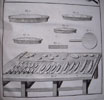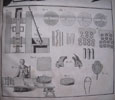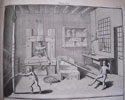Description et Details des Arts
DU MEUNIER, DU VERMICELIER ET DU BOULENGER; Avec une Histoire abrégée de la Boulengerie, & un Dictonnaire de ces Arts. Par M. MALOUIN. M.DCC.LXVII.
FIRST AND SOLE EDITION. 1767. Large folio. 430x295mm 1fep. Title page. [1] 2pp Table des Titres et Chapitres. (1)2-340. 10pp of Engraved plates; 2pp of the Meunier (Miller) ; 2pp of the Vermicelier (Pasta maker) ; 6pp of the Boulenger (Baker). 1fep. All pages very clean. Contemporary dark brown calf spine with blue marbled boards and calf tips. Spine with raised bands, gilt lines and red gilt label. Externally very slightly rubbed but overall in excellent condition.
- The outstanding full page engraved plates chronicle the methods, equipment and final product of the Miller, Pasta maker and Baker. The book is full of precise instructions pertaining to the three trades, particularly the Baker. It details everything from the quality and storage of the wheat berries to the methods of stone grinding, to the oven construction and equipment used for processing and baking. In an article online called 'The Pristine Loaf' by Hildegard Pickles, there is a chapter detailing the changeover to Yeast. Sour-dough had remained for centuries the only leavening agent for bread making. This was also the case in France, where it represented the sole raising agent, except for cake making purposes for which brewer's yeast was used until pressed yeast replaced it. In the 17th century a fundamental change took place that is chronicled by Malouin in this book. When the changeover to yeast occurred, there was a protest, as the Medical Faculty in Paris did not approve. A resolution taken by them on 24 March 1668 resulted in no majority gained for the use of yeast alone, and only after a further resolution was made by the French parliament on 21 March 1670 were bakers allowed to use yeast. The resolution also demanded that it must be fresh and obtained from a Parisian brewery, and that it should also be mixed with sour-dough. (A typical political decsion trying to appease 3 trades at once and ending up with a mish-mash of a raising agent). The yeast in those days was obviously different and the process was changing and evolving over time. Bakers could no longer rely on the same product and had to evolve as well. One wonders how consistent the loaves were. It must have been a frustrating time for the them individually and as a trade. The beautiful and impressive plates are sometimes found at auction and fetch on their own, silly money. In the complete state with a full compliment of plates, a very rare, fascinating and handsome book.






click on image to enlarge

Antiquarian category
ref number:
11087